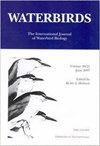Harvest Mortality of Mallards (Anas platyrhynchos) Banded at Lake St. Clair, CAN and Western Lake Erie, USA
IF 0.6
4区 生物学
Q3 ORNITHOLOGY
引用次数: 2
Abstract
Abstract. Coastal marshes of Lake St. Clair, in southwest Ontario, CAN and Lake Erie, in northwest Ohio, USA are important migratory staging locations for waterfowl despite experiencing substantial wetland losses. Waterfowl habitat management at these locations focuses on providing food resources for Mallards (Anas platyrhynchos), a highly sought game species. We examined direct recovery rates of Mallards banded prior to the 2014, 2015, and 2016 hunting seasons as a measure of harvest mortality. We compared harvest mortality between the two locations, among years, among four sex and age cohorts, and as a function of body condition. We found that banding location for juvenile Mallards was an important variable predicting harvest mortality. The probability of being a direct recovery was 126% greater for juvenile females and 70% greater for juvenile males banded at Lake St. Clair compared to those banded in northwest Ohio. Average body condition was slightly less for juvenile male Mallards banded in northwest Ohio during 2016 compared to those banded in 2015 or those banded in LSC in 2014 or 2015. We did not detect any other significant differences related to body condition and location or location-year with respect to direct recovery rates. We hypothesize that harvest mortality of juvenile Mallards could be related to differences in harvest regulations, bird abundances, or hunter density between the two study sites, all of which may have different implications for those interested in managing Mallard populations in the lower Great Lakes region.在加拿大圣克莱尔湖和美国伊利湖西部被绑带的绿头鸭(Anas platyrhynchos)的死亡率
摘要加拿大安大略省西南部的圣克莱尔湖和美国俄亥俄州西北部的伊利湖的沿海沼泽是水禽重要的迁徙集结地,尽管它们经历了大量的湿地损失。在这些地点的水禽栖息地管理的重点是为野鸭(Anas platyrhynchos)提供食物资源,野鸭是一种备受追捧的狩猎物种。我们研究了在2014年、2015年和2016年狩猎季节之前被捆绑的绿头鸭的直接恢复率,作为收获死亡率的衡量标准。我们比较了两个地点之间的收获死亡率,在年份之间,在四个性别和年龄队列之间,以及作为身体状况的函数。研究发现,幼绿头鸭的围带位置是预测收获死亡率的重要变量。在圣克莱尔湖被捆绑的雌幼鱼直接恢复的可能性比在俄亥俄州西北部被捆绑的雌幼鱼高126%,雄幼鱼高70%。2016年在俄亥俄州西北部被捆绑的年轻雄性绿头鸭的平均身体状况略低于2015年或2014年或2015年在LSC被捆绑的绿头鸭。我们没有发现与身体状况和位置或位置-年份有关的任何其他显著差异。我们假设幼鸭的收获死亡率可能与两个研究地点之间的收获规则、鸟类丰度或猎人密度的差异有关,所有这些都可能对那些对管理大湖区下游绿头鸭种群感兴趣的人有不同的影响。
本文章由计算机程序翻译,如有差异,请以英文原文为准。
求助全文
约1分钟内获得全文
求助全文
来源期刊

Waterbirds
生物-鸟类学
CiteScore
1.30
自引率
0.00%
发文量
0
审稿时长
6-12 weeks
期刊介绍:
Waterbirds is an international scientific journal of the Waterbird Society. The journal is published four times a year (March, June, September and December) and specializes in the biology, abundance, ecology, management and conservation of all waterbird species living in marine, estuarine and freshwater habitats. Waterbirds welcomes submission of scientific articles and notes containing the results of original studies worldwide, unsolicited critical commentary and reviews of appropriate topics.
 求助内容:
求助内容: 应助结果提醒方式:
应助结果提醒方式:


